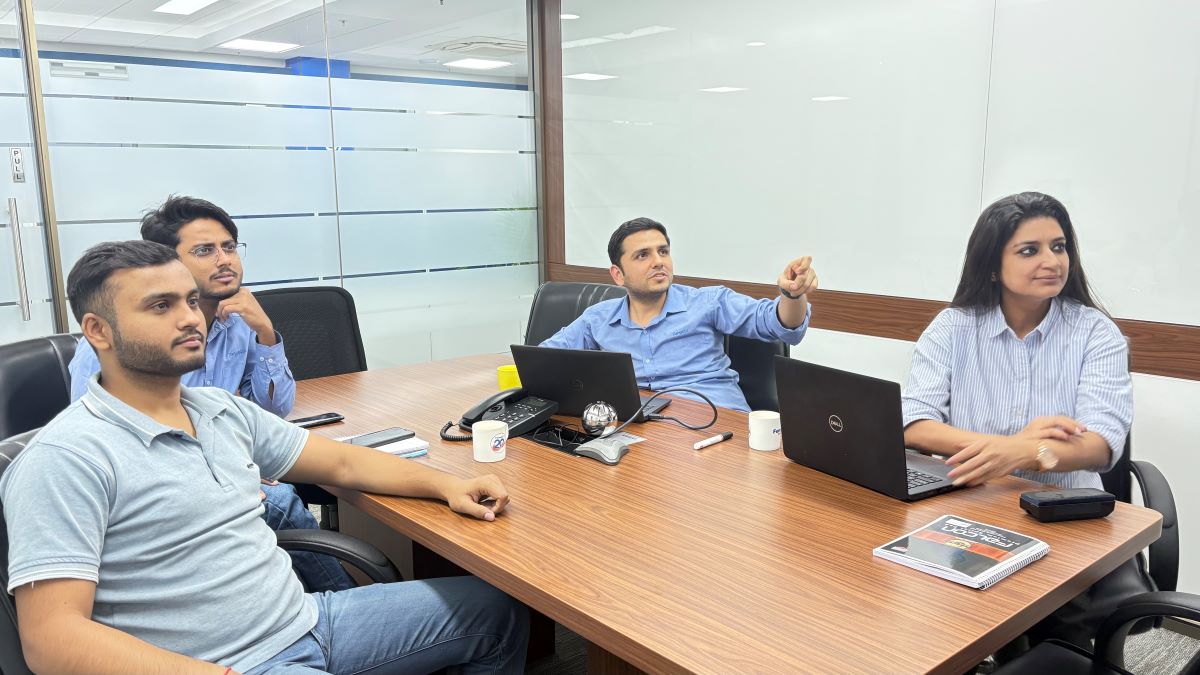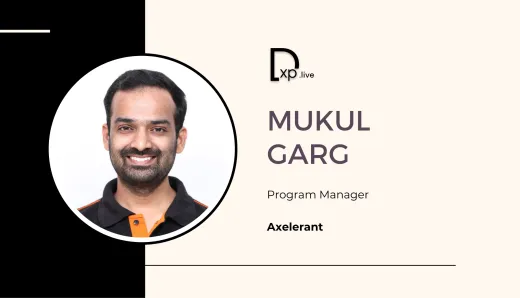Gautam Solanki on Leading Digital Transformation in Manufacturing and Infrastructure
Fenesta’s Digital Transformation Manager, Gautam Solanki, talks about building resilient digital strategies, overcoming challenges, and the future of tech in transformation.

Gautam Solanki’s Bio:
Gautam Solanki is a seasoned Digital Transformation Manager at Fenesta, bringing years of expertise in leveraging advanced technologies to drive organizational growth and efficiency. With a robust background that includes researching at the Indian Institute of Remote Sensing (ISRO) and contributing to large-scale infrastructure projects, Gautam excels at integrating digital solutions tailored to specific industry needs. His experience spans from implementing AI-driven analytics and space technology for monitoring to adopting intuitive, cross-functional digital systems that streamline operations. A keen advocate for staying ahead in tech, Gautam is known for his strategic approach to bridging business goals with innovative digital tools, enhancing productivity, and enabling measurable outcomes.
Introduction:

In this in-depth interview, Gautam Solanki, Digital Transformation Manager at Fenesta, shares his insights on navigating the challenges of digital transformation within the manufacturing and infrastructure sectors. He discusses the strategic importance of digital tools beyond cost-cutting, revealing how process improvements, cloud migration, and data flow optimization are redefining operational efficiency. Gautam also sheds light on his approach to overcoming resistance to change, the significance of cross-departmental alignment, and his vision for emerging technologies like AI, AR, blockchain, and space tech in transforming industries.
Q: What are some common challenges you face in implementing digital transformation initiatives, especially in sectors like manufacturing? How do you overcome them?
Gautam: Digital transformation in sectors like EPC (engineering, procurement, and construction) and manufacturing faces unique challenges. This industry began embracing digital transformation later than others, such as finance, and COVID-19 accelerated the need to start this journey. "One challenge is the lack of industry-specific solutions; most tools are geared toward finance or IT, so vendors are now adapting their solutions based on our requirements."
"Another major hurdle is legacy systems and resistance to change among employees accustomed to older methods." People often work in silos, which hinders cross-departmental understanding. We address this by conducting workshops with each department, identifying their challenges, finding market solutions to showcase to management, and demonstrating how these tools can improve processes and ROI.
Q: How do you handle resistance to change, especially from employees who may not be tech-savvy?
Gautam: Overcoming resistance requires a mix of user-friendly design and training. We replicate the familiar elements of legacy systems in new platforms but enhance them with modern, intuitive interfaces. This approach minimizes the learning curve. "We also draw inspiration from widely used social media apps, creating interfaces similar to WhatsApp or Facebook etc which employees are familiar with." By mirroring this experience in work applications, employees find it easier to adapt to new systems.
Q: How do you track the success of digital transformation over time, and what metrics do you use?
Gautam: Success tracking begins by setting a baseline. For example, we document the current state and track improvements over six-month intervals. Key performance indicators (KPIs) vary by function. For sales, it might be lead-to-order conversions and daily customer interactions; for marketing, click-through rates and funnel conversions. "We use these KPIs to measure progress and adjust if needed, embedding them into employees' KRAs to ensure accountability."

Q: How quickly can digital transformation yield results, and have you encountered instances where it didn’t meet expectations?
Gautam: Digital transformation benefits can be tangible and intangible. In some cases, results are visible within a year, especially for specific functions. However, "achieving full organizational impact may take around five years, depending on business goals." While results might occasionally fall short, it often highlights areas for process improvement rather than failure. For instance, time saved through digital tools can be reallocated to higher-priority tasks, driving value over time.
Q: What’s your approach to managing coordination across departments during large-scale transformations?
Gautam: "Cross-functional alignment is essential." We start by involving representatives from each department in initial workshops, where they contribute to business requirement documents. Later, we hold group workshops where all stakeholders collaborate to identify dependencies and resolve challenges collectively. This approach not only fosters collaboration but also aids in change management, as everyone understands the project's trajectory from the outset.
Q: What strategies have proven effective in fostering a culture of innovation and adoption of new digital tools?
Gautam: "A phased approach is crucial. We provide hands-on training, meet team members in each zone, and address their concerns directly." Management also supports this by conducting reviews on digital platforms, reinforcing usage. We appoint digital champions in each zone to support ongoing queries and track adoption rates. This support system, combined with regular feedback from management, gradually embeds digital practices within daily operations.
Q: Companies often focus on cost reduction and process streamlining in digital transformation. Are there other objectives that organizations like Fenesta aim for, and how do you balance these goals?
Gautam: While cost-cutting and process improvement are major objectives, digital transformation is crucial for staying competitive. If you don't adapt, you risk falling behind, as we've seen with companies like Nokia. "Beyond cost, transformation involves moving away from legacy systems and adopting advanced tools that improve efficiency." For instance, shifting from on-premises servers to cloud infrastructure cuts down on operational costs and maintenance. Additionally, process improvements create better data flow and visibility, allowing management to track business metrics in real time, which is invaluable.
Q: Beyond cost-cutting, are there other core objectives that organizations like Fenesta aim for in digital transformation?
Gautam: While cost reduction is a factor, digital transformation also aims to streamline processes, improve data visibility, and enhance customer experience. "By refining business processes and enabling real-time data access, we support both operational efficiency and strategic growth." Balancing these goals involves clear communication with stakeholders, ensuring they see beyond immediate cost benefits to the broader value digital transformation brings.
Q: How do you approach clients who want digital transformation but don’t fully understand it?
Gautam: Often, business functions are inspired by new technologies they see elsewhere but may not know how it fits into their business. "We start by understanding their business model and process cycle. Once we map this out, we explore tech solutions that fit naturally into their processes." This involves thorough market research and vendor comparisons to find the best solutions. For instance, if a business wants an interactive product showcase, we look for digital display solutions that enhance our customer experience, presenting the options with cost and implementation plan. This approach helps them see how digital tools can integrate and add value.
Q: Managing complex business requirements is essential in your role. How do you work with stakeholders to ensure alignment with both business and technical goals?
Gautam: We involve cross-departmental teams early in the process, especially those familiar with existing systems. "We capture each department’s requirements, challenges, and workflows in detailed business requirement documents (BRDs)." Once the BRD is ready, we review it with all relevant stakeholders to ensure it aligns with their expectations and resolve any conflicts. During development, we keep the stakeholders engaged through periodic updates, hands-on workshops, and user training, ensuring they’re comfortable with the new system well before it goes live.
Q: AI is a prominent trend, but are there other future technologies impacting digital transformation?
Gautam: Aside from AI, there’s a strong future in technologies like augmented reality (AR), virtual reality (VR), mixed reality, Digital Twins, and blockchain. For example, AR could enable customers to visualize our products in their homes before purchasing, enhancing the buying experience. "Blockchain is also becoming essential in supply chain transparency, helping track product movement and reducing delays. These emerging technologies, along with AI-driven analytics in tools like Power BI, offer actionable insights and are reshaping digital transformation." But I think one technology that will boom in the coming years is space technology. We will see a lot of practical use of space technology, much like AI, in the years to come.
Q: You’ve mentioned the potential of space technology in digital transformation. Can you elaborate on its impact?
Gautam: "Space technology holds exciting potential, especially in construction and infrastructure monitoring." For instance, satellite imagery can create 3D models of construction sites or help predict when buildings need repairs. This capability also helps in measuring land subsidence during underground tunnel operations. Organizations like L&T have already invested in space technology applications. to monitor construction impact, making it a field with transformative possibilities for real-time monitoring.
Q: Finally, how would you define a Digital Transformation Manager?
Gautam: "A Digital Transformation Manager is someone who understands both the business challenges and the technological landscape, capable of finding digital solutions that align with organizational goals. They must be able to bridge technical possibilities with business needs to drive impactful, sustainable transformation."




